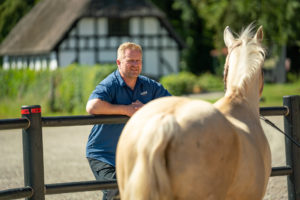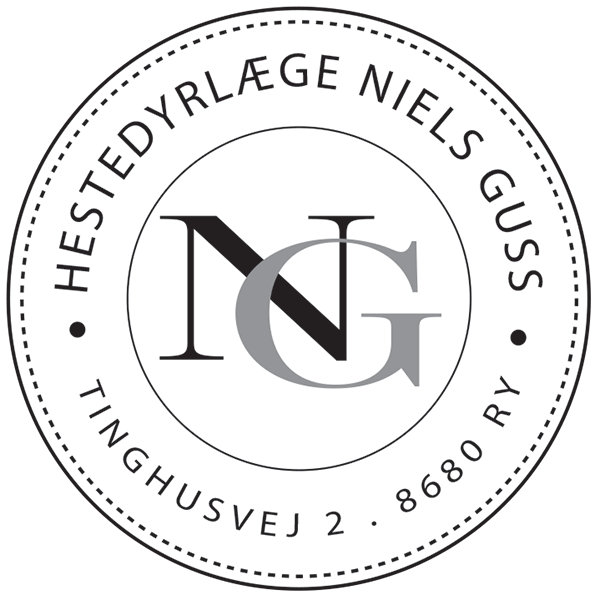The road from foal to riding horse……it hasn't become easier.
It is time for thoughtfulness.
Where is our riding horse breeding heading today?
There is always genetic improvement from one generation to the next. This applies to humans as well as animals. This, combined with the selection of good genes from stallion and mare, provides considerable improvement.
However, are we really able to keep up with the huge breeding improvement, and is it always appropriate?
More wants more, and we become increasingly greedy
More wants more, and we become increasingly greedy Today’s breeding aims at producing horses ranking at the absolute top. We all want to hit the ‘gold vein’ and produce a fantastic riding horse. We want to produce a riding horse with high leg action, spectacular and grander than last year's offspring collection. But is that actually healthy breeding? Aren't we making short-term solutions which, in the long run, will have difficulty in lasting? Aren’t we producing a breeding which moves fantastically but at the cost of, among other things, something called ridability?
We start our chase early in the horse's life. Only a few months old, the foal is entered into selection events and auction. The expectations are sky high, but is it really so easy to evaluate so young an individual, which has to grow and go through a huge development, and during the first years of its life? And, can we, if the foal is sold, get back and blame the breeder if it grows in a wrong way or develops an OCD (joint mouse). We do it just that, but it is not fair – we are dealing with a young and growing individual.
The majority of weaned foals and young horses today are in a loose-housing system, for better and for worse. Worse, if they are not imprinted and handled. Worse, when as 3-year-olds they are to start breaking in and practically are unable to be tied up and have their feet lifted. Then it is a very big and dangerous animal we are dealing with.
Some time ago, I went to the stable of an elderly man, with ten 1-year old colts together with ten 2-year-olds. We were going to work on some of these animals, and you can't help thinking how risky the day is? Is today the day to get hurt? These animals were used to being together and were tied up every day in connection with feeding. Likewise, the herd was trimmed regularly without problems. There was a calmness among these horses that I have rarely seen and which had the effect that the work was performed calm and easy and without unnecessary risk. This is professional upbringing of young horses. This means that we have very good horse material to work with during future training, breaking in, etc.
On the other hand, it is also unnatural that we place a one-year-old at a riding school, where it is not out ‘playing’ with other horses of the same age and is allowed to be a young horse and grow big and strong.
This way, we don’t achieve appropriate development of the horse, either.
We tend to focus on the best horses, the rest aren't worth much
But can this be true? The answer from here is NO!
We all want to breed top horses, but what about common riding horses. What about horses that may not walk ‘into the sky´, but have some good riding qualities that fit 90% of the riders? Shall we forget those? These horses are the cornerstone for our riders. And the cornerstone at our riding schools, etc. However, the world is getting arranged in such a way that there is no money in breeding these horses that actually count for the majority of the horse population.
We put our trust and future into stallions that have not proved themselves properly as breeding stock. They are able to move spectacularly, bordering on the supernatural and unhealthy (lurching), but where is the ridability? Where is the evaluation of the offspring? Stallions and foals are proclaimed something quite special and unique, but are they? And can we say that in such a short time and on a such sparse basis? How does it look regarding durability, etc.? And perhaps our breeding has overtaken the common rider so much that it is difficult for us to ride these horses because they place great demands on our physique, balance and technique. Do the riders spend enough time on this?
Do we focus at all on our own training and health?
We need to be fit and in shape to be able to ride our horses. It doesn’t work to lead an unhealthy life and think that we can sit on the horse for 20-25 min. every day, because everything else is too hard and then have a brilliant riding career. That doesn’t work!
Let me take a stop for a while at the term talent. That a horse has talent is often abused and may often have the result that the horse doesn’t last very long. Because, if you show talent you have to perform, and that is here and now and preferably all the time!
We have championships and shows incessantly from the time when the horse is broken in. If it shows talent, the performance pressure becomes even heavier.
But should a horse be exploited ruthlessly because it shows talent and is able to perform difficult manoeuvres at 6-7 years of age? This phenomenon makes me sad and makes me think when this horse is finished in sport. Shouldn’t we bear in mind that it is a young individual which has not finished growing until about the age of 7, and which needs time to develop? It takes years to build a horse calmly and quietly, but it takes even longer to build it so that its motivation remains intact. We have to remember that it is not a motocross bike (read: a dead thing) that we are dealing with. Now, I shall not humanize horses. They cannot reason on things the way us people can, but that is exactly why it is our responsibility to take care of these live animals and characteristics.
That a horse shows talent and at a young age can easily perform the manoeuvres is something we may just be happy about. It has to be preserved and cultivated. If, on the contrary, it is wrongly exploited, the horse has peaked its career as a 7-year-old....... then, unfortunately, the way home is far too long. After all, the horse is supposed to peak its career considerably later. Then it will be strong and can keep up with regard to both motivation and strength.
And then we have to be careful that our breeding does not become a single-track. That we do not all run stupidly in one direction based on a particular type of stallions and dictated by being able to sell the foals at a high price, because we only aim at breeding elite horses.
Excuse me, but what about grassroots?
What about the talent pool among the more common horses? A large part of these horses is not supposed to perform neither at medium nor grand prix level. That does not make them any poorer and their function is equally important, maybe even more important. Where and how else should people learn to ride. It takes years to learn, and even longer to build knowledge. It requires horses that have been given time and that are ridable and have a good temperament. Actually, that is some very important characteristics we should look for! And it takes at least a lifetime to learn to breed.
On some points, breeding has taken us in a quite different direction. Today the show jumpers are bred to rather look like thoroughbreds, which places completely different demands on the horses than it did only about 10 years ago – but they sure can jump! And even very well. However, this also places other demands on our training than it did before. Today we have to focus on strength and speed. And again, remember to vary training where it is not always essential for the horse to exercise every day on a newly dragged artificial fibre footing. They may well be exercised where things become a bit ‘crooked’, and it is good for them to move on a varied surface. It is good for horses to get out and get some experience in their everyday life.
Instead of thinking short-term solutions for our riding horses, it is allowed to think forward. A plan reaching several years. Because it takes several years to build a good horse, whether it being a show jumper or a dressage horse.
These years we are talking a lot about animal welfare. Laws have been made about stable layout and how to transport the animals.
Are we good enough at seeing whether we can even ride the horses we have bred today?
Will we learn….?
We all talk about taking care of the horses – talk and talk, but do we act? I feel that most of it drowns in good intentions and talk, with no actual interest in getting anywhere!
It is hard to be a horse today, and the biggest occupational hazard for a riding horse today is that it has a rider on its back.
A born optimist, I still believe that we are getting better and wiser at trying to understand our horses and remember to make allowance for their needs!
Summer Greetings
Niels Guss, veterinarian


